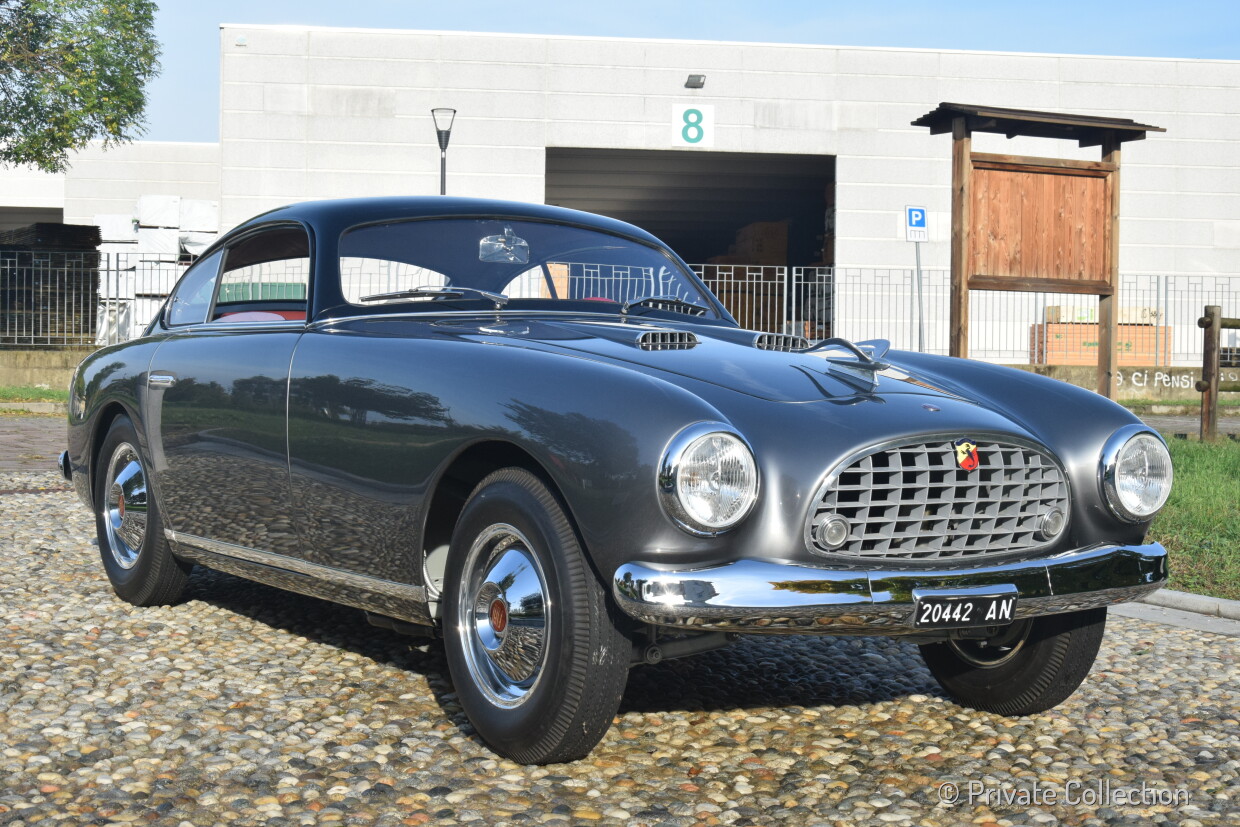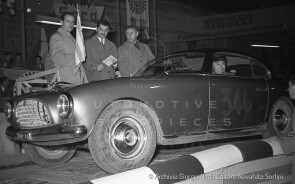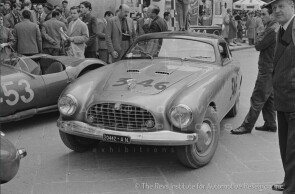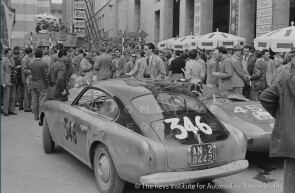
1953 Siata Gilco Fiat 1400 Berlinetta
ON/OFF
Why am I an Automotive Masterpiece?
The Fiat 1400 was manufactured between 1950 and 1958. It was introduced at the 1950 Geneva Motor Show. This model was Fiat’s first post-war offering and featured a monocoque body. Two models, the 1400 and 1900, were built on the same chassis but equipped with different engines. The trim levels of the two models varied significantly, with the 1900 being more luxurious and serving as the flagship of the Fiat range. In 1953, Fiat introduced its first diesel engine in this model. Though it was a 1900 cc engine, the car was marketed as the 1400 Diesel instead of the flagship model. Fiat offered the car in several body styles, including a 4-door saloon, a 2-door cabriolet, and a 2-door hardtop coupe. The Fiat 1400 was powered by a 1,395-cc inline four-cylinder naturally aspirated petrol engine, which featured two overhead valves per cylinder and produced 50 hp at 4,600 rpm. It generated 85 N-m of torque at 3,400 rpm, with an almost flat curve, featuring a notable output of 75 N-m at around 1,550 rpm. The power was transmitted to the rear wheels through a 4-speed manual gearbox. The engine enabled the 1,490 kg car to reach a maximum speed of 125 km/h. With dimensions considered large for European standards, the car measured 4,305 mm in length, 1,655 mm in width, and 1,550 mm in height. It was also manufactured under license by SEAT in Spain and Zastava in Yugoslavia. Aiming to produce a sporty vehicle, S.I.A.T.A. introduced the Daina in 1950, a grand touring car that incorporated mechanics derived from the Fiat 1400. It was available in two body styles: coupé and convertible. The convertible was unveiled at the Geneva Motor Show the same year, coinciding with the debut of the new Fiat 1400. This launch highlighted the ongoing collaboration between Fiat and S.I.A.T.A., a partnership that began twenty years earlier and was set to continue well into the future. Fiat had provided S.I.A.T.A. with the mechanical components of its new car even before its own model's introduction, underscoring their strong mutual collaboration.
Even though the name Gilco frequently appears as a car manufacturer in the historical records of sports cars, it actually only manufactured the tubular chassis for many of them. However, according to the regulations in use at the time by the Ministry of Transport, this attributed the paternity of the vehicle to the Milanese company. Gilco was the name given to the small artisanal workshop that used tubes produced by Angelo Luigi Colombo to make chassis designed by GC, or Gilberto Colombo, Angelo Luigi's son. Gilberto's decision in 1946 to focus on car chassis stemmed both from a desire to expand production, which was then limited to bicycle frames, and from contacts with Enzo Ferrari. Professor Mario Peruzzi, connected to the racing world as a technical consultant for Scuderia Milan, also influenced this decision. The adoption in Italy in 1947 of the international regulations for the Sport category, which liberalized the origin of the chassis, and the success in getting his tubular frames approved by the Ministry of Transport, opened up a new flourishing market for Gilco. Gilberto Colombo also considered the efficiency of the bodywork and in some cases handled it directly; indeed, Gilco also had a small body department with three panel beaters, one of whom came from Zagato. Various bodyworks were fine-tuned by Gilco for gentleman drivers, but not only for them: the company had begun to conduct style studies and had worked for Vignale and with Maserati. Many cars were designed but never materialized, including the Gilco 237, which the engineer had studied for Cisitalia, then under controlled administration. Colombo suggested to Dusio's son to build a less expensive and more widespread car than the Berlinetta 202 to allow for a greater margin for the company and had begun to design a car and assemble a tubular frame with Fiat 1400 mechanics. The car did not enter production due to the ensuing financial problems of Cisitalia, which had entered controlled administration, and the prototype was used by Colombo as his personal car.
The 1954 Siata Gilco Fiat 1400 Berlinetta (Gilco), with chassis no. M0139154M, is a car whose paternity is much debated, especially regarding the bodywork. Research has shown it was born from the “rib” of the Fiat 1400, but with a respectable pedigree, the authors being S.I.A.T.A. for the mechanics and Gilco for the rest. The bodywork, attributed over time to Zagato or Michelotti/Vignale, is actually one of the very few built by Gilco. This car began its life in February 1951 as a standard Fiat 1400 sedan (chassis no. 021341) but was completely transformed in 1953; from the analysis of the documents of the Ancona license plate, the chassis and bodywork were completed and sold by Gilco in July. Once its new “identity” was created, it was registered Milan, in March 1954, with a new chassis no. M0139154M to Ovidio Capelli. The car is one of the rare models entirely designed and produced by Gilberto Colombo. The project, initially started for S.I.A.T.A., was later dropped by the car manufacturer for economic reasons. The prototype created was among those that, in Colombo's intentions, could have led to small-scale productions on his own; however, he was never able to follow through due to excessive commitments. It remains a unique model with special features (for this reason, it is also referred to as a “Special Coupé” in the Gilco Archive). However, since historical photos consistently show the car branded as S.I.A.T.A., with a badge on the body from its earliest days to the present, we prefer to attribute it to S.I.A.T.A., despite the absence of documentation confirming its manufacture by S.I.A.T.A., pending further clarification. The car is known to have been originally commissioned by gentleman driver Ovidio Capelli, Fiat agent in Milan with close connections to the factory. His racing career spanned from the 1930s to the early 60s. He took over the management of the influential Scuderia Ambrosiana from Count Giovanni Lurani in 1949 and campaigned several cars under this banner, and commissioned lots of them, including the first-ever Zagato-bodied Fiat 8V. The Siata Gilco Fiat 1400 Berlinetta was particularly special: first, the running gear of the “quiet” Fiat 1400 was mounted by Gilco not in a box section frame, as was typical for the Siata Daina, but in a custom-made steel frame using round, square, and oval tubing. The chassis, named “Gilco 214 for Fiat 1400”, is of the “Isorigid” type and was specifically designed for the aerodynamic line of the berlinetta, which was also referred to as “Berlinetta 214” in the projects. Some original drawings of the chassis and bodywork are still present at the Gilco historical archive. A Fiat 1400 cross member with suspension attached was used at the front. At the rear, a Fiat rear-end was used with semi-elliptic springs. Because the Gilco chassis was entirely new, the original chassis number of the car (021341) was re-punched (M0139154M) by the Italian “Motorizzazione”. Your sentence is a bit convoluted and can be made clearer. The original engine, no. 024073, was most likely enhanced by S.I.A.T.A., although it may also have been modified by Abarth, as indicated by the badge initially placed on the hood. The body, made entirely of aluminum, combined sportiness with elegance; its refined details and particularly balanced lines were highlighted by two-tone paintwork. Interestingly, the frame construction and filled-in patches suggest that, as originally designed, the grille would have extended lower down, and the side lights were placed between the grille and the headlights. It is assumed these changes were made to accommodate a front bumper. There is no evidence of the first owner Ovidio Capelli ever racing it. By April of 1954, the car was owned by Roberto Montali of Ancona, a Mille Miglia veteran who entered the car in the 1954 Mille Miglia with co-driver Gaetano Bontempi but failed to finish. The registration form listed the names of the drivers, license plate, chassis, and engine numbers. Photographed during the race, the car displayed an Abarth shield on the grille, indicating a significant modification; this shield would later disappear. In the 1955 Mille Miglia, Montali teamed up with Esildo Morici, only to record another DNF. The car had lost its two-tone paintwork; it was listed in the race as a Fiat Siata and appeared to have a Siata badge. Montali sold the car in 1956, and after passing through two other Italian owners, it ended up at a dealer in Milan where Al Maggiacomo bought it in 1958. He was an American G.I. stationed in Germany, enamored with Italian cars, and during a visit to Milan, he visited a dealer specializing in racing cars. Most were Alfas and too expensive, so he purchased the S.I.A.T.A. for $2500. It was badged as a S.I.A.T.A. and had a Fiat 1400-based engine, painted in "Mediterranean Turquoise" with a red interior. He believed it had no racing history and may have been a show car. He drove the car around Europe before returning to the U.S., where he continued to use it until 1963 when his younger brother, future Trans Am champion and occasional NASCAR driver Chauncey ‘Jocko’ Maggiacomo, removed the tuned Fiat engine and installed a Triumph TR3 engine and corresponding four-speed gearbox. Jocko, aside from having a long racing career, owned a race shop in Poughkeepsie and is known for saving the life of Consalvo Sanesi by pulling him from his burning Alfa GTZ. The car, now registered as a 1957 S.I.A.T.A., passed through several hands before ending up in a junkyard in New Paltz, NY, and eventually arrived in Vermont in the possession of Dave DuBrul. The respected collector was initially unsure of the car's origins but, once identified, managed to locate two genuine S.I.A.T.A. 1400 engines. S.I.A.T.A. had close associations with Fiat and obtained engines on which they stamped their own serial numbers. These engines were modified to various degrees before leaving the factory. The two engines found by DuBrul were one mildly modified, the other heavily modified for racing. In 1985, Peter Voorhees claims he found the car in a flea market or salvage yard in Stowe, Vermont; he certainly bought it from DuBrul. Voorhees restored the car over several years with the assistance of John de Boer, compiler of The Italian Car Registry, who meticulously researched the car’s early history in Italy. Much of the chassis remained original, though new engine mounts were needed before a period-correct engine could be installed. The aluminum body was also largely complete and required relatively little new panel work. Voorhees installed one of the S.I.A.T.A. engines in the car, using parts from the race-prepared engine, including the 1500 crankshaft. The car, now equipped with the modified 1669cc S.I.A.T.A. four-cylinder engine, was subsequently shown at numerous events, including the 2010 Amelia Island Concours d’Elegance. The car is now in a private collection and was thoroughly restored again from 2017 to 2019; the front bumper was rebuilt, and the body returned to its original two-tone livery. The restoration was carried out by Carrozzeria Gatti in Bergamo coordinated by the American expert Donald Osborbe. During the restoration, Gilco, represented by Martino Colombo, son of Gilberto, had the opportunity to inspect the car and thus verify the chassis' compliance with the Gilco design in all visible portions. Following these checks, the car was registered in 2023 in the GILCO HISTORIC REGISTER under number RGS 006. The car also received a FIVA pass. It has been featured in magazine articles and in books such as MILLE MIGLIA'S CHASSIS Vol. III by Sandro Binelli.





